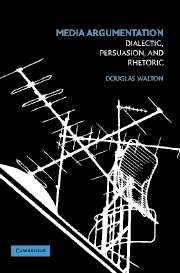Book contents
- Frontmatter
- Contents
- Acknowledgments
- Introduction
- 1 Logic, Dialectic, and Rhetoric
- 2 The Speech Act of Persuasion
- 3 Propaganda
- 4 Appeals to Fear and Pity
- 5 Ad Hominem Arguments in Political Discourse
- 6 Arguments Based on Popular Opinion
- 7 Fallacies and Bias in Public Opinion Polling
- 8 Persuasive Definitions and Public Policy Arguments
- 9 The Structure of Media Argumentation
- Bibliography
- Index
- Plate section
5 - Ad Hominem Arguments in Political Discourse
Published online by Cambridge University Press: 05 June 2012
- Frontmatter
- Contents
- Acknowledgments
- Introduction
- 1 Logic, Dialectic, and Rhetoric
- 2 The Speech Act of Persuasion
- 3 Propaganda
- 4 Appeals to Fear and Pity
- 5 Ad Hominem Arguments in Political Discourse
- 6 Arguments Based on Popular Opinion
- 7 Fallacies and Bias in Public Opinion Polling
- 8 Persuasive Definitions and Public Policy Arguments
- 9 The Structure of Media Argumentation
- Bibliography
- Index
- Plate section
Summary
The ad hominem, or personal attack, argument is now highly familiar in politics, especially in the use of negative campaign tactics in elections. This form of argument has been studied previously in the argumentation literature, but it has some special features of interest as a mass media argument strategy. In this chapter it is shown how it has some features comparable to appeals to fear and pity when it is used in mass media as a device of persuasion. This chapter brings out the multi-agent structure of the ad hominem argument as used in rhetorical argumentation, by showing how the proponent mounts a successful strategy in this form of argumentation. It is shown how he or she must use prolepsis by probing into the commitments of the respondent and configuring them in a certain way prior to the attack. These insights into the multi-agent structure of the ad hominem reveal how the proponent must collect evidence proactively, and then use this evidence to attribute a plan to the respondent. The aim is not just to reveal how to use such a tactic of personal attack in the mass media. The analysis is meant to be helpful to both voters and political campaigners, giving them a better understanding of how to deal with rhetorical ad hominem arguments by identifying, analyzing, and critically evaluating them.
The ad hominem argument is not a new phenomenon in American political discourse. A pamphlet was circulated telling of Andrew Jackson's “youthful indiscretions.
Information
- Type
- Chapter
- Information
- Media ArgumentationDialectic, Persuasion and Rhetoric, pp. 161 - 197Publisher: Cambridge University PressPrint publication year: 2007
